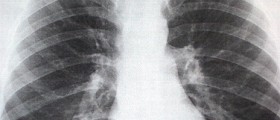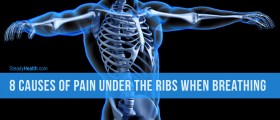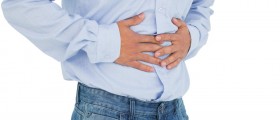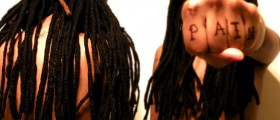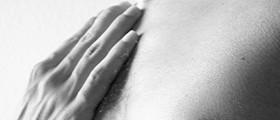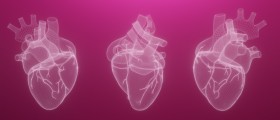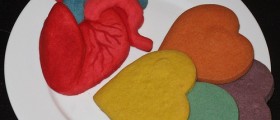Few days ago I woke up with pain in my ribs. I was so scared at that moment but after few hours the pain was gone. I would like if you could tell me if some conditions have rib pain as a symptom? Maybe something is really wrong with me.
Loading...
You need to visit your doctor regarding that rib pain, especially if you experience it again. I can not tell you what your condition is without examining you. You need to think if maybe you have hurt your ribs before you had that episode of the pain. I will try to give you some information that can be useful. However, you need to know that if you experience that pain again, you need to visit your doctor. There are a lot of things that can cause rib pain. Bruised, cracked or fractured rib is the obvious reason. Also, inflammation of cartilage near the breastbone is possible reason and this condition is called costochondritis. Osteoporosis is mainly affecting the women and it can also cause rib pain. What is your condition, only your doctor can tell you after the examination. Physical examination may include emphasis on the lungs and chest cavity, bone scan is recommended especially in the cases of bone cancer in family. Hope that I have helped you and that you will be ok.
Loading...
This might help you!
Costochondritis---You have chest pain. You probably think that you have a heart disease. Chest
pain may also be a symptom of costochondritis. If you have costochondritis don’t worry.
Costochondritis is a benign condition. Costochondritis is inflammation of the rib cage
muscles. It is a common cause of chest pain in children and adolescents. Most frequently it
affects young adults between 20 and 40 years old. In contrast to myocardial ischemia or
infarct, costochondritis is a benign cause of chest pain.
Costochondritis occurs in women and people over age 40, can affect anyone, even infants and
children. When costochondritis is accompanied by swelling it is called Tietze's syndrome.
You shoul know that Tietze syndrome is often referred to as costochondritis, but the two are
distinct conditions.
In most of cases the cause is unknown, idiopathic, and costochondritis goes away without
treatment. When the cause is unknown the goal of treatment is pain relief.
If you have chest pain you should know that it is medical emergency. Underlying diseases
which can cause chest pain can be very serious. Chest pain may be caused by heart diseases,
lung diseases, gastrointestinal problems and costochondritis. When you have chest pain your
doctor will first rule out heart disease. You will have some tests; they are needed to rule
out other diseases. If chest pain isn’t caused by heart disease you probably have
costochondritis.
You should know that costochondritis affects more woman than men. In some cases this
condition can be caused by infection.
What are the signs and symptoms of costochondritis?
Pain and tenderness are localized in the places where your ribs attach to your breastbone.
If you have costochondritis you will feel sharp pain or gnawing pain. Pain caused by
costochondritis can occur on either side of your chest, but occurs most often on the left
side of your breastbone. Pain is usually worsened by activity or exercise. Because of the
many nerves that branch away from the chest, you can feel pain in the shoulder or arms as
well.
Most common symptoms of costochondritis are: pain when coughing, pain when taking deep
breaths, difficulty breathing. When you movement stops, pain decreases. Chest pain is
usually preceded by exercise, or an upper respiratory infection or minor trauma. This chest
pain increases as you take deep breath. When you take deep breath you stretch the inflamed
cartilage and that can cause exquisite pain. Sometimes simply touching the area involved
will be extremely painful for you.
What are the causes of costochondritis?
Cause of costochondritis in most of cases is unknown, usually it has no definite cause. But
there are some cases where the cause can be determined. Costochondritis can be caused by
injury; a blow to the chest could also cause costochondritis.
Infection also can be cause of costochondritis. Viral respiratory infections, bacterial
infections after surgery and very rare fungal infection are known causes of costochondritis.
This condition commonly occurs with viral respiratory infections because of the inflammation
rib cage muscles from the viral infection itself, or from straining from coughing. When
costochondritis recurs that can be sign of fibromyalgia. Patient who have fibromyalgia often
have several tender spots. The upper part of the breastbone is a common tender spot.
Repeated minor trauma to the chest wall also can be cause of this costochondritis.
Frequently, surgery to upper chest can be cause of costochondritis.
If you have chest pain you should see a doctor. Only doctor can diagnose costochondritis.
There are difference between costochondritis pain and pain caused by heart attack.
Costochondritis pain is localized on small area, and pain caused by heart attack is more
widespread. Heart attack pain may worsen with stress or physical activity. Costochondritis
pain is constant. Never try to diagnose by yourself chest pain, leave that for your doctor.
Every chest pain should be taken very serious.
Screening and diagnosis
To help your doctor make the right diagnose, you must describe your chest pain. Pain of
costochondritis can be very similar to the pain associated with heart disease, lung disease,
and gastrointestinal problems. So doctors often missdiagnose costochondritis.
Costochondritis is also a common cause of chest pain in children and adolescents.
There are no tests for costochondritis, this condition can't be seen on chest X-rays or
other imaging tests.
When doctor suspect that you have costochondritis my order some tests to rule out other
conditions. The only way to diagnose this condition is to take your personal medical
history and to do physical exam. Costochondritis occurs fairly frequently in people who had
cardiac surgery.
What is the treatment for costochondritis?
Patients with costochondritis usually don’t need any treatment. Costochondritis pain usually
lasts a week or two and then goes away. In some cases doctor can prescribe nonsteroidal
anti-inflammatory drugs such as ibuprofen (Advil, Motrin, others) and naproxen (Aleve). You
should discuss with your doctor about those medication because they have some side effects.
Nonsteroidal anti-inflammatory medications can help decrease symptoms of pain, also they
help decrease inflammation, which is the primary problem. Some doctors prescribed tricyclic
antidepressants if pain is making it difficult to sleep.
Your doctor may give you a local anesthetic and steroid injection in the area that is
tender, if the pain does not respond to medications. Very rare surgery (removal of the
sore cartilage) is performed. If costochondritis is caused by infection usually treatment s
are IV antibiotics.
The pain should improve within a few weeks, and resolve completely within six months.
There are patients in whom this problem persists for some time. If you have chest pain
which last more than few months see your doctor. If you had the costochondritis once that
does not increase your chances of experiencing the symptoms again.
Self - care
There are several helpful things to do in order to help manage the symptoms of
costochondritis. Self - care is most important part of treatment. You should rest, and
avoid activites which make your pain worse. In order to decrease the inflammation, you
should avoid activities that cause pain and inflammation. Deep breathing, exercise, and
strain on the muscles of the chest may worsen pain and slow the healing process. Avoid or
limit activities that worsen your pain.
Walking or swimming can keep your body healthy. When exercise increases your pain you should
stop. Also you can apply heating pad to the painful area several times a day. Local heat or
ice may be helpful to relieve pain. Ice packs or heating ads these techniques help to
decrease your pain may help you better manage your symptoms. You should find out more about
chronic pain. The pain associated with costochondritis significantly improves within the
first 4-8 weeks. Some pain may persist, it is only associated with strenuous activity.
How to prevent costochondritis?
There is no prevention for this condition because costochondritis has no definite cause
Costochondritis---You have chest pain. You probably think that you have a heart disease. Chest
pain may also be a symptom of costochondritis. If you have costochondritis don’t worry.
Costochondritis is a benign condition. Costochondritis is inflammation of the rib cage
muscles. It is a common cause of chest pain in children and adolescents. Most frequently it
affects young adults between 20 and 40 years old. In contrast to myocardial ischemia or
infarct, costochondritis is a benign cause of chest pain.
Costochondritis occurs in women and people over age 40, can affect anyone, even infants and
children. When costochondritis is accompanied by swelling it is called Tietze's syndrome.
You shoul know that Tietze syndrome is often referred to as costochondritis, but the two are
distinct conditions.
In most of cases the cause is unknown, idiopathic, and costochondritis goes away without
treatment. When the cause is unknown the goal of treatment is pain relief.
If you have chest pain you should know that it is medical emergency. Underlying diseases
which can cause chest pain can be very serious. Chest pain may be caused by heart diseases,
lung diseases, gastrointestinal problems and costochondritis. When you have chest pain your
doctor will first rule out heart disease. You will have some tests; they are needed to rule
out other diseases. If chest pain isn’t caused by heart disease you probably have
costochondritis.
You should know that costochondritis affects more woman than men. In some cases this
condition can be caused by infection.
What are the signs and symptoms of costochondritis?
Pain and tenderness are localized in the places where your ribs attach to your breastbone.
If you have costochondritis you will feel sharp pain or gnawing pain. Pain caused by
costochondritis can occur on either side of your chest, but occurs most often on the left
side of your breastbone. Pain is usually worsened by activity or exercise. Because of the
many nerves that branch away from the chest, you can feel pain in the shoulder or arms as
well.
Most common symptoms of costochondritis are: pain when coughing, pain when taking deep
breaths, difficulty breathing. When you movement stops, pain decreases. Chest pain is
usually preceded by exercise, or an upper respiratory infection or minor trauma. This chest
pain increases as you take deep breath. When you take deep breath you stretch the inflamed
cartilage and that can cause exquisite pain. Sometimes simply touching the area involved
will be extremely painful for you.
What are the causes of costochondritis?
Cause of costochondritis in most of cases is unknown, usually it has no definite cause. But
there are some cases where the cause can be determined. Costochondritis can be caused by
injury; a blow to the chest could also cause costochondritis.
Infection also can be cause of costochondritis. Viral respiratory infections, bacterial
infections after surgery and very rare fungal infection are known causes of costochondritis.
This condition commonly occurs with viral respiratory infections because of the inflammation
rib cage muscles from the viral infection itself, or from straining from coughing. When
costochondritis recurs that can be sign of fibromyalgia. Patient who have fibromyalgia often
have several tender spots. The upper part of the breastbone is a common tender spot.
Repeated minor trauma to the chest wall also can be cause of this costochondritis.
Frequently, surgery to upper chest can be cause of costochondritis.
If you have chest pain you should see a doctor. Only doctor can diagnose costochondritis.
There are difference between costochondritis pain and pain caused by heart attack.
Costochondritis pain is localized on small area, and pain caused by heart attack is more
widespread. Heart attack pain may worsen with stress or physical activity. Costochondritis
pain is constant. Never try to diagnose by yourself chest pain, leave that for your doctor.
Every chest pain should be taken very serious.
Screening and diagnosis
To help your doctor make the right diagnose, you must describe your chest pain. Pain of
costochondritis can be very similar to the pain associated with heart disease, lung disease,
and gastrointestinal problems. So doctors often missdiagnose costochondritis.
Costochondritis is also a common cause of chest pain in children and adolescents.
There are no tests for costochondritis, this condition can't be seen on chest X-rays or
other imaging tests.
When doctor suspect that you have costochondritis my order some tests to rule out other
conditions. The only way to diagnose this condition is to take your personal medical
history and to do physical exam. Costochondritis occurs fairly frequently in people who had
cardiac surgery.
What is the treatment for costochondritis?
Patients with costochondritis usually don’t need any treatment. Costochondritis pain usually
lasts a week or two and then goes away. In some cases doctor can prescribe nonsteroidal
anti-inflammatory drugs such as ibuprofen (Advil, Motrin, others) and naproxen (Aleve). You
should discuss with your doctor about those medication because they have some side effects.
Nonsteroidal anti-inflammatory medications can help decrease symptoms of pain, also they
help decrease inflammation, which is the primary problem. Some doctors prescribed tricyclic
antidepressants if pain is making it difficult to sleep.
Your doctor may give you a local anesthetic and steroid injection in the area that is
tender, if the pain does not respond to medications. Very rare surgery (removal of the
sore cartilage) is performed. If costochondritis is caused by infection usually treatment s
are IV antibiotics.
The pain should improve within a few weeks, and resolve completely within six months.
There are patients in whom this problem persists for some time. If you have chest pain
which last more than few months see your doctor. If you had the costochondritis once that
does not increase your chances of experiencing the symptoms again.
Self - care
There are several helpful things to do in order to help manage the symptoms of
costochondritis. Self - care is most important part of treatment. You should rest, and
avoid activites which make your pain worse. In order to decrease the inflammation, you
should avoid activities that cause pain and inflammation. Deep breathing, exercise, and
strain on the muscles of the chest may worsen pain and slow the healing process. Avoid or
limit activities that worsen your pain.
Walking or swimming can keep your body healthy. When exercise increases your pain you should
stop. Also you can apply heating pad to the painful area several times a day. Local heat or
ice may be helpful to relieve pain. Ice packs or heating ads these techniques help to
decrease your pain may help you better manage your symptoms. You should find out more about
chronic pain. The pain associated with costochondritis significantly improves within the
first 4-8 weeks. Some pain may persist, it is only associated with strenuous activity.
How to prevent costochondritis?
There is no prevention for this condition because costochondritis has no definite cause
Loading...





